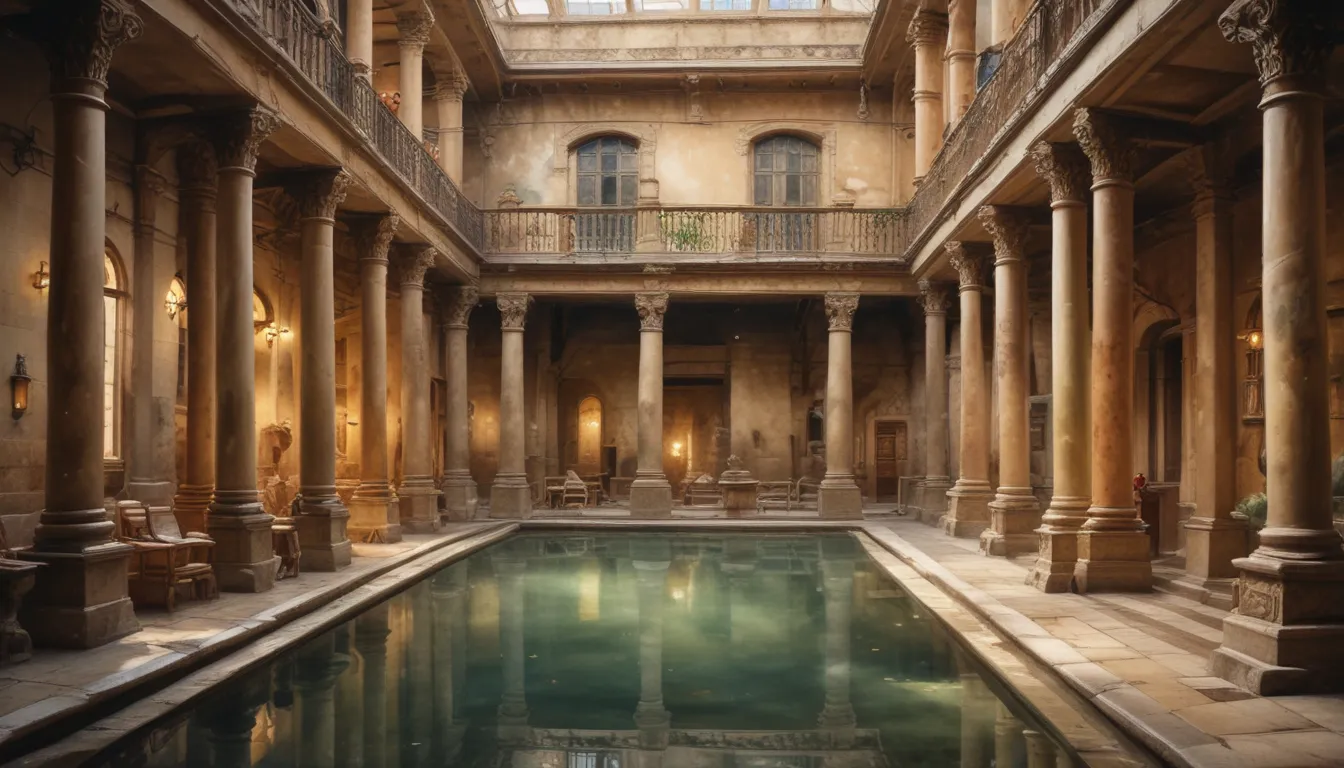The images in our articles are for illustrative purposes only and may not exactly match the content. They are intended to capture your interest and complement the text, not to replace it.
Welcome to the enchanting world of the Roman Baths in Bath, England! These ancient structures are not just a tourist hotspot but a captivating archaeological wonder that offers a peek into the lives of the Romans over 1,800 years ago. Join us as we delve into the depths of history and uncover 18 astounding facts about the Roman Baths, showcasing their historical significance, architectural magnificence, and cultural importance. Let’s embark on this exciting journey to explore the secrets of the past and unravel the mysteries of one of the most iconic landmarks in the world.
Unraveling the Roman Baths: A Glimpse into History and Architecture
1. The Roman Baths were built around 70 AD.
The construction of the Roman Baths commenced during the reign of Emperor Vespasian and was finalized around 70 AD under the rule of his son, Emperor Titus.
2. A well-preserved ancient bathing complex awaits.
Nestled in the picturesque city of Bath, England, the Roman Baths stand as a testament to Roman architectural and engineering prowess, perfectly preserved for generations to behold.
3. Dedicated to the goddess Sulis Minerva.
The Baths were consecrated to Sulis Minerva, a fusion of the local Celtic goddess Sulis and the Roman goddess Minerva, reflecting the cultural blend of traditions in the ancient world.
4. Therapeutic hot springs flow abundantly.
Featuring natural hot springs that produce approximately 1.17 million liters of water daily, the Roman Baths offer warm, mineral-rich waters believed to possess healing properties.
5. The Great Bath steals the spotlight.
At the heart of the complex lies the Great Bath, a sprawling rectangular pool enriched with Roman stonework, where communal bathing and social gatherings took place in the bygone era.
Unveiling the Intricacies of Roman Bathing Culture
6. An intricate heating and plumbing system.
The Roman Baths boasted a sophisticated network of underground pipes that circulated the hot springs’ waters to various baths and chambers throughout the expansive complex.
7. Welcoming visitors from diverse backgrounds.
The Baths were a hub for individuals from all echelons of society, including soldiers, merchants, and even slaves, who indulged in bathing, socializing, and business transactions within its walls.
8. Therapeutic allure of the Baths’ waters.
Believing in the therapeutic value of the mineral-rich waters, visitors flocked to the Roman Baths seeking relief from various ailments, immersing themselves in the healing properties of the hot springs.
9. Segregation by gender in bathing facilities.
Reflecting societal norms, the Roman Baths featured separate areas for men and women, offering distinct bathing amenities and social spaces catering to each gender’s needs.
10. Diverse activities beyond bathing.
In addition to bathing, Romans partook in recreational pursuits at the Baths, engaging in board games, performances, massages, and beauty treatments, creating a vibrant social atmosphere.
Rediscovery and Cultural Significance of the Roman Baths
11. Revival in the 18th century.
After centuries of obscurity, the Roman Baths were rediscovered in the 18th century, reigniting interest in ancient Roman culture and architectural achievements, marking a resurgence of appreciation for the past.
12. Fusion of Roman and Celtic architectural styles.
The architectural design of the Baths harmoniously blends Roman techniques with Celtic influences, resulting in a unique and compelling aesthetic that captivates visitors to this day.
13. Recognition as a UNESCO World Heritage site.
Acknowledging its historical and cultural importance, the Roman Baths received UNESCO World Heritage status in 1987, solidifying its significance as a global treasure.
14. A magnet for millions of visitors annually.
Continuing to mesmerize audiences worldwide, the Roman Baths draw millions of visitors each year, eager to explore the rich history and grandeur of this ancient marvel.
15. Immersive museum experience.
Adjacent to the Baths stands a museum showcasing a wide array of artifacts unearthed from the site, from religious relics to everyday objects, providing a tangible link to the past for visitors.
Embracing the Enchantment of the Roman Baths: A Contemporary Perspective
16. Cinematic and televised appearances.
The Roman Baths have graced the screens of movies and TV shows, adding to their allure and charm as an iconic symbol of ancient Roman civilization, captivating audiences across mediums.
17. Interactive educational exhibits for visitors.
To enrich the visitor experience, the Roman Baths feature interactive exhibits that offer insights into the site’s history and significance, using multimedia displays and engaging activities to educate and entertain.
18. Embarking on a Timeless Journey.
In conclusion, the Roman Baths stand as a beacon of history, blending architectural splendor with therapeutic benefits to transport visitors back in time to a world of luxury and communal bathing. Whether you seek archaeology, architecture, or relaxation, a visit to the Roman Baths promises an unforgettable experience.
FAQs: Navigating Through Curiosities
Q: Are the Roman Baths still operational for bathing today?
A: No, the Roman Baths are preserved as an archaeological site and are no longer used for bathing.
Q: Can visitors swim in the Roman Baths?
A: No, swimming is prohibited in the Roman Baths to ensure the preservation of the historical site.
Q: Is it safe to drink water from the Roman Baths?
A: Drinking water from the Roman Baths is not allowed due to the untreated nature of the water and its mineral content.
Q: Are guided tours available for visitors?
A: Yes, guided tours provide valuable insights into the history and significance of the Roman Baths, enhancing the visitor experience.
Q: Are photography and videography permitted within the Roman Baths?
A: Personal photography is generally allowed, excluding flash photography and tripods to protect the artifacts and structures within the premises.
Explore More Historic Marvels: A Tapestry of Time
If the Roman Baths have stirred your curiosity, why not venture into other remarkable historic sites? Discover the mysteries of the Leaning Tower of Pisa’s iconic tilt, journey into Ancient Rome’s profound history, or immerse yourself in the architectural marvels of the Basilica of Maxentius. Each destination offers a unique window into the past, waiting for intrepid minds like yours to unravel their secrets. Which adventure will you embark on next?
Your Journey Through History and Culture Begins Here
Our commitment to delivering authentic and engaging content is a cornerstone of our dedication to enriching your knowledge and experiences. Every fact shared on our platform is contributed by individuals like you, ensuring a diverse and accurate pool of insights. Our meticulous editorial process guarantees the highest standards of reliability and credibility, offering you a trusted resource as you engage with history, culture, and beyond. Trust in our pursuit of quality and authenticity as you explore, learn, and journey through the realms of knowledge with us.






